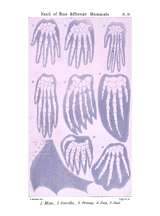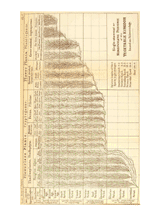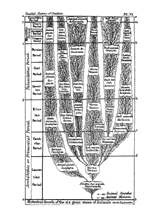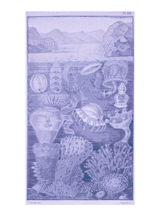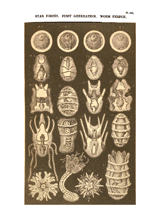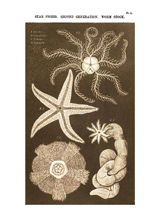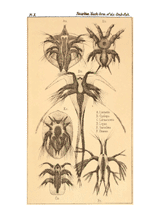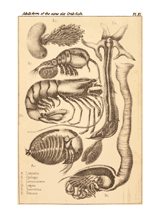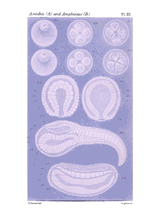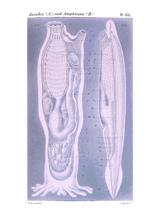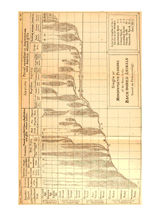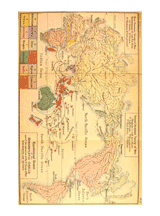


THE
HISTORY OF CREATION:
OR THE DEVELOPMENT
OF THE EARTH AND ITS
INHABITANTS BY THE ACTION OF NATURAL CAUSES.
A POPULAR EXPOSITION OF
THE DOCTRINE OF EVOLUTION IN GENERAL, AND THAT OF
DARWIN, GOETHE, AND LAMARCK IN PARTICULAR.
From the German of
ERNST HAECKEL
Professor in the University of Jena.
The Translation Revised by
Professor E. RAY LANKESTER, M.A., F.R.S.,
Fellow of Exeter College, Oxford.
In Two Volumes
Volume II
New York:
D. APPELTON AND COMPANY
1876
This electronic edition prepared by Dr.
David C. Bossard
from original documents in his personal library.
January, 2006.
Copyright © 2006 by David C. Bossard.
CONTENTS.
Titlepage i i
Superscription (Wordsworth) ii ii
CHAPTER
XV.
PERIODS OF CREATION AND RECORDS OF
CREATION.
001
002
003
004
005
006
007
008
009
010
011
012
013
014
015 016
017
018
019 020
021
022
023
024
025
026
027 028
029
030
031
032
033
034
035
Reform of Systems by the Theory of Descent. -- The Natural System as a
Pedigree. -- Palæontological Records of
the Pedigree. -- Petrifactions as Records of
Creation. -- Deposits of the Neptunic Strata and
the Enclosure of Organic Remains. -- Division of
the Organic History of the Earth into Five Main Periods: Period of the
Tangle Forests, Fern Forests, Pine Forests, Foliaceous Forests, and of
Cultivation. -- The Series of Neptunic Strata.
-- Immeasurable Duration of the Periods which have elapsed
during their Formation. -- Deposits of Strata
only during the Sinking, not during the Elevation of the Ground.
-- Other Gaps in the Records of Creation. -- Metamorphic
Condition of the most Ancient Neptuntic Strata. -- Small
Extent of Palæontological Experience. -- Small
proportion of Organisms and of Parts of Organisms Capable of Petrifying.
-- Rarity of many Petrified Species. -- Want
of Fossilised Intermediate Forms. -- Records of
the Creation in Ontogeny and in Comparative Anatomy.
CHAPTER
XVI.
PEDIGREE AND HISTORY OF THE KINGDOM OF
THE PROTISTA.
036
037
038
039
040
041
042
043
044
045
046
047
048
049
050
051
052
053
054
055
056
057
058
059
060
061
062
063
064
065
066
067
068 069
070
071
072
073 074
075
076
Special Mode of Carrying out the Theory of Descent in the Natural
System of Organisms. -- Construction of
Pedigrees. -- Descent of all Many-celled from
Single-celled Organisms. -- Descent of Cells
from Monera. -- Meaning of Organic Tribes, or
Phyla. -- Number of the Tribes in the Animal and
Vegetable Kingdoms. -- The Monophyletic
Hypothesis of Descent, or the Hypothesis of one Common Progenitor, and
the Polyphyletic Hypothesis of Descent, or the Hypothesis of many
Progenitors. -- The Kingdom of Protista, or
Primæval Beings. -- Eight Classes of the
Protista Kingdom: Monera, Amœbæ, or Protoplastæ;
Whip-swimmers, or Flagellata; ated-balls, or Cili Catallacta;
Labyrinth-streamers, or Labyrinthuleæ; Flint-cells, or
Diatomeæ; Mucous-mou1ds, or Myxomycetes; Root-footers (Rhizopoda).
-- Remarks on the General Natural History of the Protista:
Their Vital Phenomena, Chemical Composition, and Formation
(Individuality and Fundamental Form). -- Pliylogeny
of the Prostista Kingdom.
CHAPTER XVIL
PEDIGREE AND HISTORY OF THE
VEGETABLE KINGDOM.
077
078
079
080
081
082 083
084
085
086
087
088
089
090
091
092
093
094 095
096
097
098
099
100
101
102
103
104
105
106
107
108
109
110
111
112
113
114
115
The Natural System of the Vegetable Kingdom. -- Division
of the Vegetable Kingdom into Six Branches and Eighteen Classes.
-- The Flowerless Plants (Cryptogamia). -- Sub-kingdom
of the Thallus Plants. -- The Tangles, or
Algæ (Primary A1gæ, Green Algæ, Brown Algæ, Red
Algæ) -- The Thread-plants, or Inophytes
(Lichens and Fungi). -- Sub-kingdom of the
Prothallus Plants. -- The Mosses, or
Muscinæ (Water-mosses, Liverworts, Leaf-mosses, Bog-mosses).
-- The Ferns, or Filicinæ (Leaf-ferns, Bamboo-ferns,
Water-ferns, Scale-ferns). -- Sub kingdom of
Flowering Plants (Phanerogamia). -- The
Gymnosperms, or Plants with Naked Seeds (Palm-ferns = Cycadæ;
Pines = Coniferae.) -- The Angiosperms, or
Plants with Enclosed Seeds. -- Monocotylæ.
-- Dicotylæ. -- Cup-blossoms
(Apetalæ). -- Star-b1ossoms
(Diapetalæ). -- Bell-blossoms
(Gamopetalæ)
CHAPTER
XVIII.
PEDIGREE AND HISTORY OF THE ANIMAL
KINGDOM.
I. ANIMAL-PLANTS AND WORMS.
117
118
119 120
121
122
123
124
125
126
127 128
129
130
131
132
133
134
135
136
137
138
139
140
141
142
143
144
145
146
147
148
149
150
151
152
153
154
The Natural System of the Animal Kingdom. -- Linnæus
and Lamarck's Systems. -- The Four Types of
Bär and Cuvier. -- Their Increase to Seven
Types. -- Genealogical Importance of the Seven
Types as Independent Tribes of the Animal Kingdom. -- Derivation
of Zoophytes and Worms from Primeval Animals. -- Monophyletic
and Polyphyletic Hypothesis of the Descent of the Animal Kingdom.
-- Common Origin of the Four Higher Animal Tribes out of
the Worm Tribe. -- Division of the Seven Animal
Tribes into Sixteen Main Classes, and Thirty-eight Classes.
-- Primeval Animals (Monera, Amœbæ, Synamœbæ),
Gregarines, Infusoria, Planæades, and Gastræades (Planula
and Gastrula). -- Tribe of Zoophytes.
-- Spongiæ (Mucous Sponges, Fibrous Sponges,
Calcareous Sponges). -- Sea Nettles, or
Aca1ephæ Corals, Hood-jellies, Comb-jellies). -- Tribe
of Worms.
CHAPTER
XIX
PEDIGREE AND HISTORY OF THE ANIMAL
KINGDOM.
II. MOLLUSCA, STAR-FISHES,
AND ARTICULATED ANIMALS.
154
155
156
157
158
159
160
161
162
163
164
165
166
167
168 169
170
171
172
173 174
175
176
177
178
179
180
181
182 183
184
185
186
187
188
189
190
191
Tribe of Molluscs. -- Four Classes of Molluscs:
Lamp-shells (Spirobranchia); Mussels (Lamellibranchia); Snails
(Cochlides); Cuttle-fish (Cephalopoda). -- Tribe
of Star-fishes, or Echinoderma. -- Their
Derivation from Ringed Worms (Mailed Worms, or Phracthelminthes).
-- The Alternation of Generation in the Echinoderma.
-- Four Classes of Star-fish: Sea-stars (Asteridea);
Sea-lilies (Crinoidea); Sea-urchins (Echinidea); Sea-cucumbers
(Holothuridea). -- Tribe of Articulated Animals,
or Arthropoda. -- Four Classes of Articulated
Animals: Branchiata, or Crustacea, breathing through gills; Jointed
Crabs; Mailed Crabs; Articulata Tracheata, breathing through Air Tubes.
-- Spiders (Long Spiders, Round Spiders). -- Myriopods.
-- Insects. -- Chewing and Sucking
Insects. -- Pedigree and History of the Eight
Orders of Insects
CHAPTER
XX
PEDIGREE AND HISTORY OF THE ANIMAL
KINGDOM.
III. VERTEBRATE ANIMALS.
192
193
194 195
196
197
198
199
200
201
202
203
204
205
206
207
208
209
210
211
212
213
214
215 216
217
218
219 220
221
222
223
224
225
226
227 228
229
230
The Records of the Creation of Vertebrate Animals (Comparative Anatomy,
Embryology, and Palontology). -- The Natural System of
Vertebrate Animals. -- The Four Classes of
Vertebrate Animals, according to Linnæus and Lamarck.
-- Their Increase to Nine Classes. -- Main
Class of the Tube-hearted, or Skull-less Animals (the Lancelet).
-- Blood Relationship between the Skul-less Fish and the
Tunicates. -- Agreement in the Embryological
Development of Amphioxus and Ascidiæ. -- Origin
of the Vertebrate Tribe out of the Worm Tribe. -- Main
Class of Single-nostriled, or Round-mouthed Animals (Hag and Lampreys).
-- Main Class of Anamnionate Animals, devoid of Amnion.
-- Fishes (Primeval Fish, Cartilaginous Fish, Osseous Fish).
-- Mud-fish, or Dipneusta. -- Sea
Dragons, or Halisauria. -- Frogs and
Salamanders, or Amphibia (Mailed Amphibia, Naked Amphibia).
-- Main Class of Amnionate Animals, or Amniota.
-- Reptiles (Primary Reptiles, Lizards, Serpents,
Crocodiles, Tortoises, Flying Reptiles, Dragons, Beaked Reptiles).
-- Birds (Feather-tailed, Fan-tailed, Bush-tailed.)
CHAPTER
XXI
PEDIGREE AND HISTORY OF THE ANIMAL
KINGDOM.
IV. MAMMALS.
231
232
233
234
235
236
237
238
239
240
241
242
243
244
245
246
247
248
249
250
251
252
253
254
255
256
257
258
259
260
261
262
The System of Mammals according to Linnæus and Blainville.
-- Three Sub-classes of Mammals (Ornithodelphia, Didelphia,
Monodelphia). -- Ornithodelphia, or Monotrema.
-- Beaked Animals (Ornithostoma). -- Didelphia,
or Marsupials. -- Herbivorous and Carnivorous
Marsupials. -- Monodelphia, or Placentalia
(Placental Animals). -- Meaning of the Placenta.
-- Tuft Placentalia. -- Girdle
Placentalia. -- Disc Placentalia. -- Non-deciduates,
or Indeciduata. -- Hoofed Animals. --
Single and Double-hoofed Animals. -- Whales.
-- Toothless Animals. -- Deciduates,
or Animals with Decidua. -- Semi-apes.
-- Gnawing Animals. -- Pseudo-hoofed
Animals. -- Insectivora. -- Beasts
of Prey. -- Bats. -- Apes
CHAPTER
XXII.
ORIGIN AND PEDIGREE OF MAN.
263
264
265
266
267
268 269
270
271
272
273 274
275
276
277
278
279
280
281
282 283
284
285
286
287
288
289
290
291
292
293
294 295
The Application of the Theory of Descent to Man. -- Its
Immense Importance and Logical Necessity. -- Man's
Position in the Natural System of Animals, among Disco-placental
Animals. -- Incorrect Separation of the Bimana
and Quaclrumana. -- Correct Separation of
Semi-apes from Apes. -- Man's Position in the
Order of Apes. -- Narrow-nosed Apes (of the Old
World) and Flat-nosed Apes (of America). -- Difference
of the two Groups. -- Origin of Man from
Narrow-nosed Apes. -- Human Apes, or
Anthropoides. -- African Human-apes (Gorilla and
Chimpanzee). -- Asiatic Human-apes (Orang and
Gibbon). -- Comparison between the different
Human Apes and the different Races of Men. -- Survey
of the Series of the Progenitors of Man. -- Invertebrate
Progenitors (Prochordata) and Vertebrate Progenitors.
CHAPTER XXIII
MIGRATION AND DISTRIBUTION
OF MANKIND. HUMAN SPECIES AND HUMAN RACES.
296
297
298
299
300
301
302
303
304
305
306
307
308
309
310
311
312
313
314
315 316
317
318
319 320
321
322
323
324
325
326
327 328
329
330
331
332
333
Age of the Human Race. -- Causes of its Origin.
-- The Origin of Human Language. -- Monophyletic
or Single, Polyphyletic or Multiple Origin of the Human Race.
-- Derivation of Man from many Pairs. -- Classification
of the Human Races. -- System of Twelve Species
of Men. -- Woolly-Haired Men, or Ulotrichis.
-- Bushy-Haired (Papuans, Hottentots.) -- Fleecy-haired
(Caffres, Negroes). -- Straight-haired Men, or
Lissotrichi. -- Stiff-haired (Australians,
Malays, Mongols, Arctic, and American Tribes). -- Curly-haired
(Dravidas, Nubians, Midlanders) -- Number of
Population. -- Primæval Home of Man (South
Asia, or Lemuria). -- Nature of Primæval
Men. -- Number of Primæval Languages
(Monoglottists and Polyglottists). -- Divergence
and Migration of the Human Race. -- Geographical
Distribution of the Human Species
CHAPTER
XXIV.
OBJECTIONS AGAINST, AND PROOFS OF THE
TRUTH OF, THE THEORY OF DESCENT.
334
335
336
337
338
339
340
341
342
343
344
345
346
347
348
349
350
351
352
353
354
355
356
357
358
359
360
361
362
363
364
365
366
367
368 369
370
Objections to the Doctrine of Filiation. -- Objections
of Faith and Reason. -- Immeasurable Length of
the Geological Periods. -- Transition Forms
between Kindred Species. -- Dependence of
Stability of Form on Inheritance, and of the Variability of Form on
Adaptation. -- Origin of very Complicated
Arrangement of Organisation. -- Gradual
Development of Instincts and Mental Activities. -- Origin
of à priori Knowledge
from Knowledge à posteriori.
-- The Knowledge requisite for the Correct Understanding of
the Doctrine of Filiation. -- Necessary
Interaction between Empiricism and Philosophy. -- Proofs
of the Theory of Descent. -- Inner
Causal-Connection between all the Biological Series of Phenomena.
-- The Direct Proof of the Theory of Selection.
-- Relation of the Theory of Descent to Anthropology.
-- Proofs of the Animal Origin of Man. -- The
Pithecoid Theory as an Inseparable Part of the Theory of Descent.
-- Induction and Deduction. -- Gradual
Development of the Human Mind. -- Body and Mind.
-- Human Soul and Animal Soul. -- A
Glance at the Future.
LIST OF WORKS REFERRED TO IN THE TEXT 371
372
373 374
375
376
377
378
APPENDIX (Explanation of the Plates) 379
380
381
382 383
384
385
386
387
388
389
390
391
392
393
394 395
396
397
398
399
400
401
INDEX 402
403
404
405
406
407
408
LIST
OF ILLUSTRATIONS.
PLATES (below).
IV. Hand of Nine different Mammals To face page 34
V. Single-Stemmed, or Monophyletic, Pedigree of the Vegetable
Kingdom " 112
VI. Historical Growth of the Six Great Stems of Animals " 122
VII. Animal Plants, or Zoophytes " 140
VIII. Star Fishes -- First Generation " 170
IX. Star Fishes-Second Generation " 171
X. Nauplius-Youth-Form of Six Crab Fish " 174
XI. Adult-Form of the same Six Crab Fish " 175
XII Ascidia and Amphioxus " 201
XIII. Ascidia and Aixiphioxus " 202
XIV. Single, or Monophyletic, Pedigree of Back-boned
Animals " 222
XV. Hypothetical Sketch of the Monophyletic Origin of
Man Frontispiece
FIGURES.
8. Protamœba Primitiva 52
9. Bathybius Hæcke1ii 53
10. Amœba Sphærococcus 54
11. Euglena Striata 57
12. Magosphæra Planula 58
13. Labyrinthula Macrocystis 59
14. Navicula Hippocampus 60
15. Physarum Albipes 61
16. Cyrtidosphæra Echinoides 66
17. Caulerpa Denticulata 87
18. Euastrum Rota 88
19. Fucus Vesiculosus (egg of) 90
High resolution images of all plates and figures are here.



